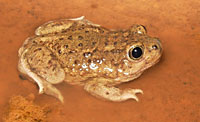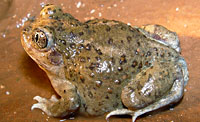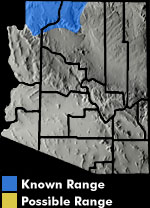Online Field Guide to The Reptiles and Amphibians of Arizona


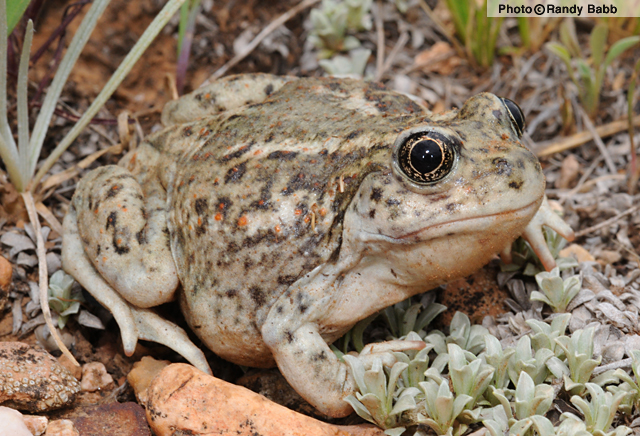
Coconino County, AZ
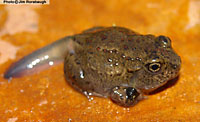 Metamorph. Coconino Co., AZ |
| GREAT BASIN SPADEFOOT Spea intermontana | |
|
DESCRIPTION: To about 2.5 inches in length, the Great Basin spadefoot is usually gray or olive, with reddish-orange glandular dorsal spots, and often an hourglass pattern on its back formed by light streaks. A dark brown spot is usually present on each upper eyelid; and a raised, glandular boss is present between the eyes (the similar Plains Spadefoot has a bony boss between the eyes). The eyes are large and have vertical pupils. It is named for a wedge-shaped, black spade-like structure found on the bottom of each hind foot, which are used to dig burrows. The inner three digits of the forelimbs are darkened in breeding males. Great Basin spadefoots may smell like peanuts when handled. Tadpoles grow to about 2.8 inches, and are gray or gray-brown with a broad, rounded head and eyes positioned high on top of the head. DISTRIBUTION: This species is found in northwestern Arizona in the Arizona Strip region north and west of the Colorado River, including lower Hurricane Valley, Pakoon Basin, near the Virgin River, the Beaver Dam Slope, Vermillion Cliffs, and the Kaibab and Paria plateaus. A BLM checklist for the Arizona Strip describes the species as common in aquatic habitats. HABITAT: Great Basin spadefoots inhabit a variety of vegetation communities from Mohave and Great Basin Desertscrub to open coniferous woodlands. Breeds in both permanent as well as ephemeral still or slow-moving waters. BEHAVIOR: Great Basin spadefoots spend the winter and some dry periods in burrows they excavate themselves or that rodents have created. Emergence and surface activity is often, but not always, triggered by rainfall. The species is primarily nocturnal, but metamorphs and juveniles may be active by day. REPRODUCTION AND CALLS: Unlike southern Arizona spadefoots, which breed exclusively during the summer monsoon season, Great Basin spadefoots emerge and begin breeding in the spring (probably April in Arizona) and continue into at least early June. The precise extent of the breeding season in Arizona is unknown, but in adjacent states breeding can extend into July. Females deposit 300-1,000 black eggs in discrete clusters of 20-40 eggs attached to vegetation; tadpoles metamorphose in 30-60 days. The call of the male Great Basin spadefoot has been described as a grating and loud “waah waah” or “gwaa gwaa”. DIET: Great Basin spadefoots eat large numbers of ants, but also beetles, beetle larvae, as well as other insects, arachnids, and snails. The tadpoles are primarily omnivorous – predacious or carnivorous morphs are rarely found. REMARKS: This species thrives in man-made impoundments, such as cattle tanks, and is tolerant of some other forms of disturbance that create sites and circumstances for standing water during the breeding season, such as flooded pastures or the margins of agriculture. Other species of frogs and toads are typically absent from Great Basin spadefoot breeding sites. By Jim Rorabaugh Brennan, T.C., and A.T. Holycross. 2006. A Field Guide to Amphibians and Reptiles in Arizona. Arizona Game and Fish Department. Phoenix, AZ. Hovingh, P., B. Benton, and D. Bornholdt. 1985. Aquatic parameters and life history observations of the Great Basin spadefoot toad in Utah. Great Basin Naturalist 45(1):22-30. Morey, S.R. 2005. Spea intermontana (Cope, 1883) Great Basin Spadefoot. Pages 571-519 in M.J. Lannoo (ed), Amphibian Declines: The Conservation Status of United States Species. University of California Press, Berkeley, CA. Stebbins, R.C. 2003. A Field Guide to Western Reptiles and Amphibians, Third Edition. Houghton Mifflin Company, Boston, MA. Wright, A.H., and A.A. Wright. 1949. Handbook of frogs and toads of the United States and Canada. Third edition, Comstock Publishing Association, Ithaca, New York. |
|
Visit Partners in Amphibian and Reptile Conservation:


HOME
Copyright © 2023, Arizona Game and Fish Department. All rights reserved.
If you make use of the textual contents of this site in reports, publications, etc. please cite and credit the author(s) and photographer(s). All photos on this website are copyrighted. However, those found in the species account section may be used for any noncommercial scientific, educational, or conservation purposes provided that photographs are not altered and continue to bear the copyright symbol and name of the photographer. Please contact the photographer regarding commercial use of copyrighted photographs.










